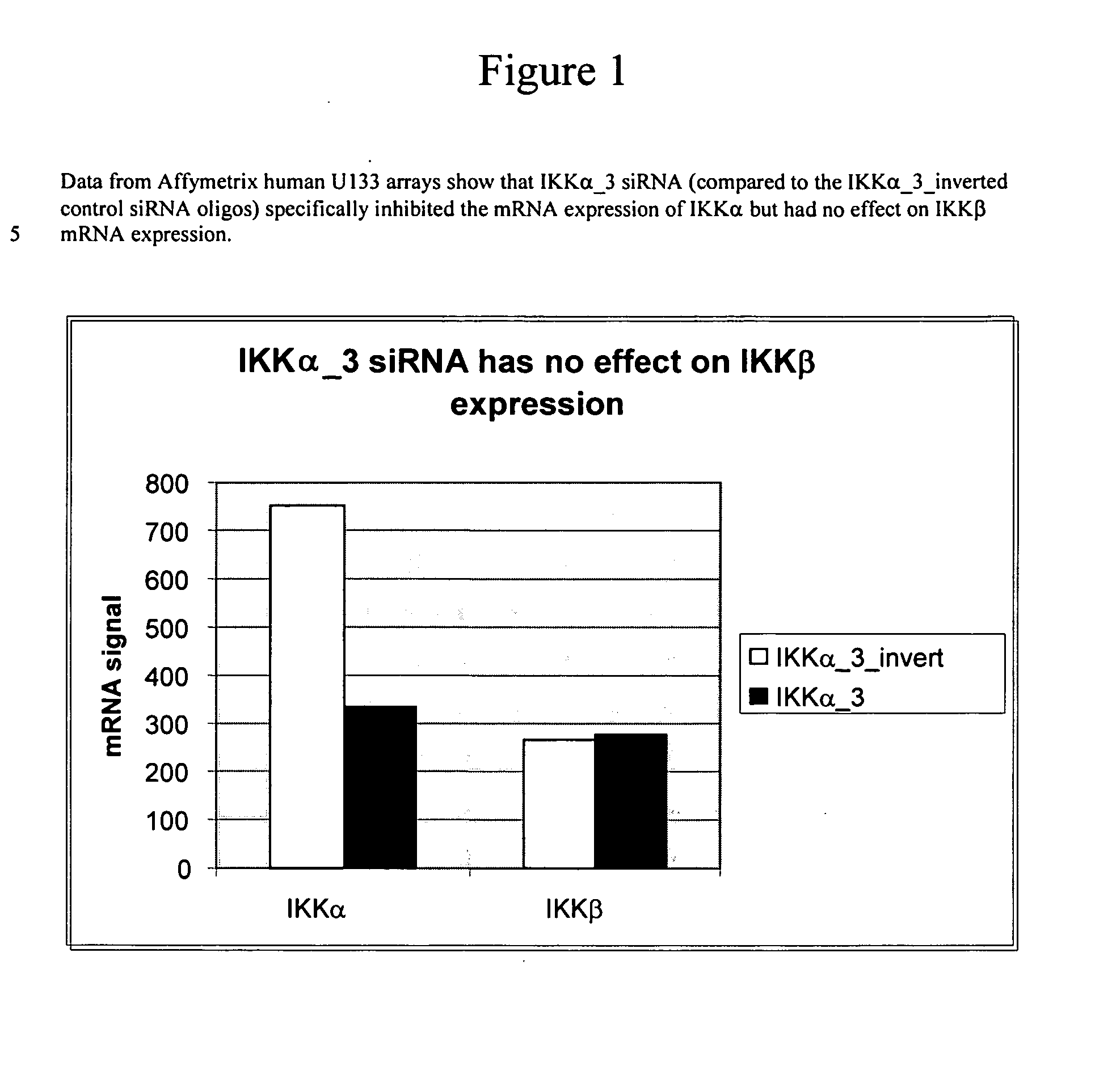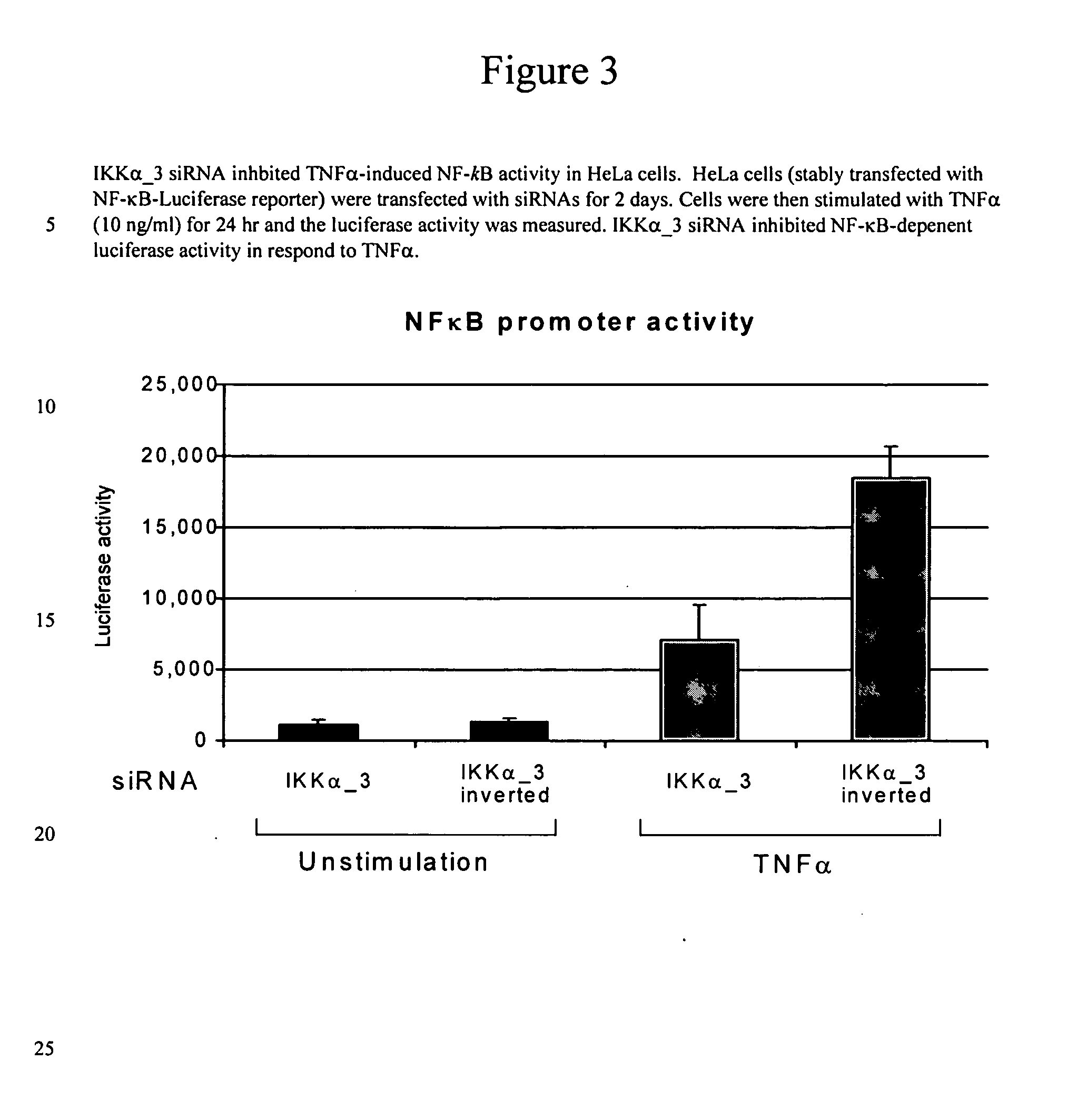Methods for modulating IKKalpha activity
a technology of ikkalpha activity and modulation method, applied in the direction of instruments, peptide/protein ingredients, genetic material ingredients, etc., can solve the problem of effective gene silencing
- Summary
- Abstract
- Description
- Claims
- Application Information
AI Technical Summary
Problems solved by technology
Method used
Image
Examples
example 2
[0097] Delivery of siRNA to HeLa Cells
[0098] Transfection of siRNA Duplexes
[0099] Delivery of siRNA duplexes was performed with OLIGOFECTAMINE.TM. reagent available from Invitrogen (Carlsbad, Calif.). The samples were prepared in a 6 well format. Transfection efficiencies were found to be about 80%.
[0100] For each well of a 6 well plate, one tube containing 10 .mu.l of 20 .mu.M siRNA duplex with 90 .mu.l of Opti-MEM, and in a separate tube 4 .mu.l of OLOGOFECTAMIN.TM. reagent with 96 .mu.l of Opti-MEM were mixed and incubated for 7-10 minutes at room temperature. The two tubes were combined and incubated for another 20 to 25 minutes at room temperature. Then 800 .mu.l of fresh Opti-MEM was added to obtain a final solution of 1000 .mu.l. Then 1000 .mu.l of siRNA-OLIGOFECTAMINE.TM. was added to cultured cells (40 to 50% confluent). The cells were seeded the previous day in 6-well plates at a density of 2.times.10.sup.5 cells / well using 2 ml of DMEM tissue culture medium supplemented w...
example 3
[0101] Preparation of RNA and PCR Primers
[0102] Total RNA was prepared from the cells 2 days after delivery of siRNA's. Total cellular RNA was isolated from tissue or cell samples using the RNeasy.TM. kit and Rnase-Free DNase Set Protocol from Qiagen (Valencia, Calif.) according to the manufacturer's directions. PCR primers and TaqMan probes were designed using Primer Express 1.5 Software (Applied Biosystems, Foster, Calif.). The sequence of the PCR primers used were SEQ. ID. No. 9: 5'-GCACAGAGATGGTGAAAATCATTG-3', and SEQ. ID. No. 10: 5'-CAACTTGCTCAAATGACCAAACAG-3'. The probe sequence SeQ. ID No. 11: 5'-TGAGCACACGGTCCTGACTCTGCA labeled with a reporter fluorescent dye, FAM (6-carboxyfluorescein), at the 5' end and a fluorescent dye quencher TAMRA (6-carboxy-tetramethyl-rhodamine) at the 3' end. The specificity of PCR primers was tested under normal PCR conditions in a thermal cycler prior to TaqMan.TM. PCR quantitation. Total cellular RNA was isolated from cell samples using the RNea...
example 4
[0103] Microarray Studies Using Affymetrix
[0104] Preparation of cRNA and Gene Chip Analysis.
[0105] Preparation of cRNA, hybridization and scanning of the U133A were performed according to the manufacturer's protocol (Affymetrix, Santa Clara, Calif.). Briefly, 5-10 .mu.g of the total RNA was converted into double stranded cDNA by reverse transcription using a cDNA synthesis kit (Superscript Choice.TM., Invitrogen Carlsbad, Calif. with a special oligo(dT024 primer) (Genset, La Jolla, Calif.) containing a T7 RNA polymerase promoter site added 3' of the poly T tract. After second strand synthesis, labeled cRNA was generated from the cDNA samples by an in vitro transcription reaction supplemented with biotin-11-CTP and biotin-16-UTP (Enzo, Farmingdale, N.Y.). The labeled cRNA was purified by using RNeasy spin columns (Qiagen, Valencia, Calif.). Fifteen micrograms of each cRNA sample was fragmented by mild alkaline treatment at 94.degree. C. for 35 minutes in fragmentation buffer (40 mM T...
PUM
| Property | Measurement | Unit |
|---|---|---|
| Length | aaaaa | aaaaa |
Abstract
Description
Claims
Application Information
 Login to View More
Login to View More - R&D
- Intellectual Property
- Life Sciences
- Materials
- Tech Scout
- Unparalleled Data Quality
- Higher Quality Content
- 60% Fewer Hallucinations
Browse by: Latest US Patents, China's latest patents, Technical Efficacy Thesaurus, Application Domain, Technology Topic, Popular Technical Reports.
© 2025 PatSnap. All rights reserved.Legal|Privacy policy|Modern Slavery Act Transparency Statement|Sitemap|About US| Contact US: help@patsnap.com



